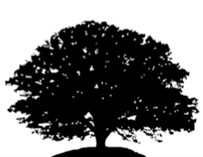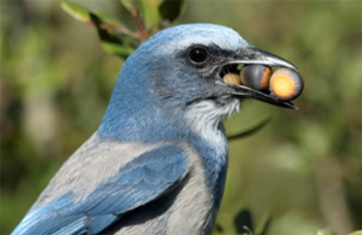Good morning, boys and girls. My name is Eric Luttrell. Today I will be offering the first of five children’s sermons presented by our Community Carbon yard science team about some special native plants. Native plants are special. They developed in our regional environment, with plants and animals evolving together to develop mutually beneficial relationships. Insects, birds, and mammals evolved interacting with a very large variety of plants, eating those plants and helping those plants with pollination and see dispersal.

This silhouette of the Oregon White Oak is recognizable when we look around the Willamette Valley. You might even recognize some of these trees from your own neighborhood.
My sermon today is about our native Oregon Oak trees. I am standing here beside Faith, one of two Oregon Oak trees that we recently planted. We are calling the second oak tree Hope. These trees will be the large canopy trees of our Reformation Earth Garden. As they mature, these canopy trees will shade large areas of understory trees and shrubs. We are lucky that we have this large area around our church to plant oaks, as they would become too big for planting in the yards around your house.
To give you an idea about how big Oregon Oak trees can get, this is a photo of an Oregon Oak tree in LuAnn Staul’s yard, so large that not all of it fits in the photo. That’s me standing next to it. This tree is five feet in diameter, about 50 fee tall, and about 300 years old. 300 years ago, when this tree was a sapling like Faith, our United States was just a small colony of the United Kingdom, consisting of 13 sub-colonies located right along the eastern shore of North America. At that time, there would have been no white Europeans in Oregon for at least 50 more years, which was also the time that we declared independence from that United Kingdom.
Oaks of this size and age will be the direct ancestors of many generations of oak trees in an oak grove of many acres. I call them Grandparent Trees. The trees descending from the grandparent trees depended upon someone planting their seeds—what we call acorns. Who does the planting of those acorns? Squirrels. Squirrels like to dig holes and bury acorns for food for next winter. And, amazingly, they remember where they buried those acorns. They remember most of them. If they forget, those acorns will sprout and grow into new oak trees. This means that the oaks and squirrels have a symbiotic relationship—a relationship of mutual benefit. The oaks feed the squirrels and the squirrels plant the oak seeds.

Now why, specifically as we planting Oregon Oaks? Scientists have discovered that oaks in general are the most important trees upon which caterpillars feed. Caterpillars are the larval stages of butterflies and other insects that feed on tree leaves. And millions and millions and millions of caterpillars are collected every spring by adult songbirds to feed their baby chicks. And the best oak trees for hosting caterpillars are native oak trees, and Oregon Oak is our native oak tree.
While our newly planted Faith and Hope look like tall sticks now, when the young children in our church are in high school, they will be 25 to 35 feet tall, as tall as the back side of the sanctuary. Now it will take some time for our two small oak trees to grow large enough to supply lots and lots of the caterpillars for baby birds. While we are waiting, the next best trees for caterpillars are native willow trees. And, lucky for us, we have several hundred native willows on our property in our wetland.
Besides caterpillars to feed baby birds, what else do oaks provide for wildlife? Acorns. All kinds of animals eat acorns—squirrels, chipmunks, birds, and deer.
In Oregon and California, the indigenous people (Indians) ate lots of acorns as a nutritious source of fats and carbohydrates. They would leach out the bitter tannins in the acorns, grind them into flour, and make a kind of bread. Since Oregon Oaks were the most common tree in the Willamette Valley (with millions of trees), and since the long-lived oaks had lots of acorns (millions and millions of acorns), acorns were an important native food source along with fish, meat, berries, and mushrooms.
Faith and Hope are the first of many trees, shrubs, flowers, and grasses that we will plant in this area around me just outside our back patio. We intend to call this area our Reformation Earth Garden. With time, this garden will be the home of more than 40 different varieties of native plants. And because most of these 40 new varieties are different from the many, many varieties of native plants currently found in our wetland and forest, we are greatly expanding the diversity of our local ecosystem.
We will be planting these native plants as part of our responsibility to improve our environment for all living creatures. With time, we hope that this garden will become part of what Douglas Tallamy in his book Nature’s Best Hope calls America’s Homegrown National Park, with a variety of native plants in every yard.
Eric Luttrell

